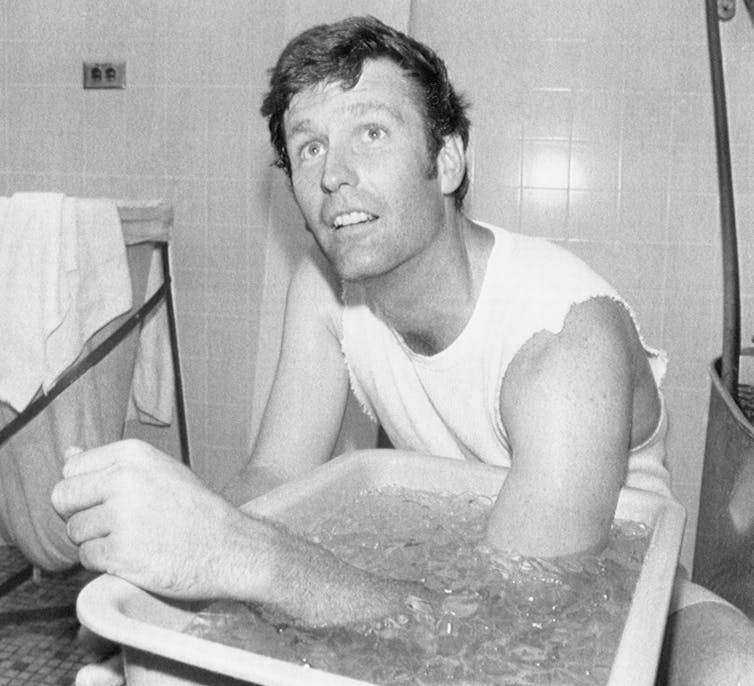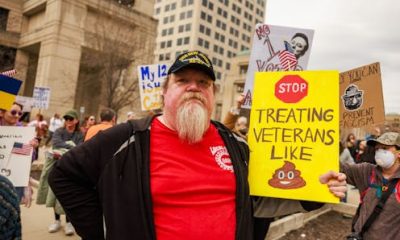
Tommy John pitched in the big leagues from 1963 to 1989 and won 288 games. Only 25 MLB pitchers have won more.
But check out his 27 years of statistics, and you’ll see one year is blank: 1975. That’s because in the fall of 1974, John underwent surgery for a ligament tear in his elbow, an injury once considered career-ending.
John was the first pitcher to return to action after suffering such an injury. In fact, John won more games after the surgery than before – and the procedure that repaired his arm is now named after him.
John went under the knife 50 years ago. Since then, Tommy John elbow reconstruction surgery has changed the game and the people who play it, from Little Leaguers to the pros.
Tommy John ices his elbow in 1974.
Bettmann via Getty Images
How elbow ligaments tear
The ulnar collateral ligament, or UCL, is a band of fibrous tissue connecting two bones – the humerus in the upper arm and the ulna in the forearm on the inside of the elbow. If you didn’t have that ligament, there would be a gap between the two bones.
This ligament plays a critical role for athletes who throw, such as football quarterbacks and baseball pitchers, because it serves as an anatomical bridge. The UCL transmits the force of the throw from the shoulder to the hand as the ball is released.
But here’s the problem: The force on the elbow generated by pitching a baseball, especially from today’s high-velocity pitchers, exceeds the strength of the ligament.
Poor mechanics and other factors stress the ligament to the point where it can tear, thus causing the need for repair. To replace the torn tissue, the surgeon typically takes a relatively unused tendon from the pitcher’s forearm or hamstring.
Arms brought back to life
Before this surgery, a tear of the UCL ended many major league pitching careers.
Case in point: Sandy Koufax, the Los Angeles Dodgers pitcher and Hall of Famer, retired in 1966 because of severe elbow pain. Koufax was only 30 years old and at the zenith of his career. Frank Jobe, the doctor who performed the first Tommy John surgery and the Dodgers’ team physician at the time, said the procedure could have been called Sandy Koufax surgery had he developed the idea earlier.
Returning to play after Tommy John surgery is not without difficulties, and recovery takes a long time; John took close to two years before he could pitch again. Although today’s surgery is much less invasive, recovery takes about a year.
About 80% of pitchers successfully return to playing after the surgery. But sometimes the repair doesn’t last forever, and about 30% of pitchers with repaired elbows undergo a second surgery.
A surge in surgeries
Since Tommy John, it’s estimated that nearly 2,500 professional baseball players have undergone the surgery, and the number of overall procedures increases about 9% a year.
One-third of current Major League Baseball pitchers had Tommy John surgery at some point. Shohei Ohtani, the Dodgers’ two-way superstar, had the procedure in 2023. While Ohtani returned to batting in 2024, he’s not expected to pitch until 2025.
There are several reasons why the number of surgeries have increased. First is the addition of a pitch clock in 2023, which works like a shot clock in basketball – pitchers must throw their next pitch within a certain time frame.
Pitchers also throw harder today than they did a half-century ago; the average velocity of pitches has increased about 4 miles per hour in the past 20 years. But pitchers who throw at higher velocities – particularly at speeds exceeding 100 miles per hour – are more likely to suffer this injury.
The rise of the sweeper pitch has also made an impact. This high-velocity breaking ball has been blamed for stressing the UCL.
One physical therapist says he sees up to five young athletes with throwing pain every week.
Young arms carry heavier loads
Today, more than half of Tommy John surgeries are performed on kids ages 15 to 19 – essentially, teenagers who are high school or college athletes.
This is happening because youth sports have changed dramatically over the decades. It is now a US$15 billion business. Between school leagues, travel ball, all-star teams and showcases, young athletes play more often; in warmer parts of the country, they go year-round. Because many of them play for different teams and different coaches, nobody is monitoring overall pitch counts.
That, along with the relentless focus on one sport at an early age, means excessive stress on the elbow. Studies show athletes who play more than one sport actually have reduced injury rates.
The Pitch Smart program, sponsored by Major League Baseball and USA Baseball, offers resources to coaches and parents to help young athletes reduce the risk of injury. But adherence to the program is strictly voluntary. A 2021 study shows 90% of surveyed teams are not complying with Pitch Smart guidelines. Many youngsters are throwing too many pitches per day and not getting enough rest between games. Either parents and coaches are not aware of the Pitch Smart recommendations or they are simply ignoring them.
Indeed, there are parents who want their children to have the surgery prior to a possible injury because they believe that using the procedure as a preventive measure will make the elbow stronger and resistant to future tears. This, however, is a myth.
Tommy John, now 81, laments that the surgery that saved his career has become a routine procedure for children whose bodies are still developing. With teenagers now the clientele for the majority of these surgeries, John has called for a return to the youth sports of the past, a time when kids played not so much for the promise of fame, riches or scholarships but simply for the fun of it.
Admittedly, there’s little profit in that. But as more and more kids go under the knife, maybe parents and coaches will finally start to listen.
The authors do not work for, consult, own shares in or receive funding from any company or organization that would benefit from this article, and have disclosed no relevant affiliations beyond their academic appointment.
Advertisement

Advertisement
Contact Us
If you would like to place dofollow backlinks in our website or paid content reach out to info@qhubonews.com











